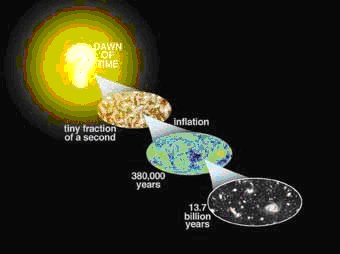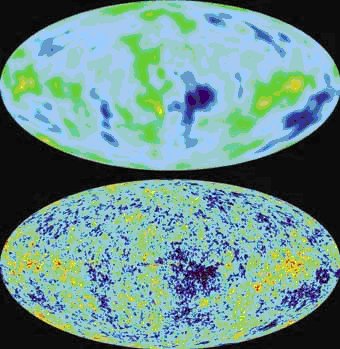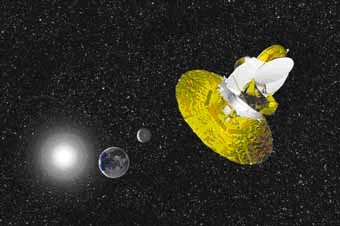博文
NASA’s Big Mistake -- 03
|
1. NASA’s Ridiculous Whole Sky MAP
The Wilkinson Microwave Anisotropy Probe (WMAP) is A NASA satellite mission lasts for many years. It gave great impact on cosmic research. The achievement of the mission is great. Many research institutes, universities were involved in this project. According to the result of this project, the overall structure and character of the universe are in the hands of the human being.
But if we abandon our awful respect to those famous scientists, throw away the blind trustful to the high tech instruments, we can find big flaw in those related reports with our independent thinking. If pay more attention and study it, then the giant project is a huge mansion build on sands. It is beautiful, but its base is totally unstable. It will crash by one finger touch.
3.1 Introduction to the Background of WMAP Project
This introduction is quite long. If you don’t have enough time or interesting, you can jump to 3.1 to read the summary of the introduction.
For save my energy, I will copy the materials from the web. The detailed information can get from NASA’s official WMAP web site: http://map.gsfc.nasa.gov/m_mm.html.
Following is copied from Wikipedia, the free encyclopedia:
The Wilkinson Microwave Anisotropy Probe (WMAP) is a NASA satellite mission to survey the sky to measure the temperature of the radiant heat left over from the Big Bang. The satellite was launched by a Delta II rocket on June 30, 2001, at 3:46 p.m. EDT from Cape Canaveral Air Force Station, Florida, USA.
WMAP was the Breakthrough of the Year for 2003 according to Science magazine.[1]
The goal of WMAP is to map out minute temperature differences in the Cosmic Microwave Background (CMB) radiation in order to help test theories of the nature of the universe. It is the successor to COBE and one of the series of medium-class explorer (MIDEX) satellites.
The science goals of the WMAP broadly dictate that the relative CMB temperature be measured accurately over the full sky with high angular resolution and sensitivity. The overriding priority in the design was the need to control systematic errors in the final maps. The specific goal of WMAP is to map the relative CMB temperature over the full sky with an angular resolution of at least 0.3°, a sensitivity of 20 ??K per 0.3° square pixel, with systematic artifacts limited to 5 ??K per pixel.
To achieve these goals, WMAP uses differential microwave radiometers that measure temperature differences between two points on the sky. WMAP observes the sky from an orbit about the L2 Sun-Earth Lagrangian point, 1.5 million km from Earth.
WMAP spacecraft diagram
This vantage point offers an exceptionally stable environment for observing, since the observatory can always point away from the Sun, Earth and Moon while maintaining an unobstructed view to deep space. WMAP scans the sky in such a way as to cover ~30% of the sky each day and as the L2 point follows the Earth around the Sun WMAP observes the full sky every six months. To facilitate rejection of foreground signals from our own Galaxy, WMAP uses five separate frequency bands from 22 to 90 GHz.
On February 11, 2003, NASA issued a press release regarding the age and composition of the universe. This release included the "best baby picture" of the universe taken up to that point. According to NASA, this picture "contains such stunning detail that it may be one of the most important scientific results of recent years". The new data were found to be in agreement with previous CMB measurements and with the most popular Lambda-CDM models.
The three-year WMAP data were released at noon on March 17, 2006. The data included temperature and polarization measurements of the CMB, which provided further confirmation of the standard flat Lambda-CDM model and new evidence in support of inflation.

Figure3-1:WMAP detected the first light of the universe – the remain of the Big Bang

Figure 3-2 Baby Universe Whole Sky Map

Figure 3-3 WMAP is running on the orbit one million kilometers away from the earth. On the back ground are the sun, the earth and the moon.
WMAP provided higher accuracy measurements of many cosmological parameters than had been available from previous instruments. According to current models of the universe, WMAP data show:
l The universe is 13.7 billion ± 200 million years old [3].[1]
l The universe is composed of:
4% ordinary baryonic matter
22% an unknown type of dark matter, which does not emit or absorb light.
74% a mysterious dark energy, which acts to accelerate expansion.
l The cosmological scenarios of cosmic inflation are in better agreement with the three-year data, although there is still an unexplained anomaly on the largest angular measurement of the quadrupole moment.
l The Hubble constant is 70 (km/s)/Mpc, +2.4/-3.2
l The data are consistent with a flat geometry.
l CMB polarization results provide experimental confirmation of cosmic inflation favoring the simplest versions of the theory.
3.2 Introduction to the Background of WMAP Project:The Theoretic Base
It is necessary to introduce some theoretic background. In such case, <A Brief History of Time> written by Stephen Hawking also save me energy.
Following are copied from the book:
Friedmann made two very simple assumptions about the universe: that the universe looks identical in whichever direction we look, and that this would also be true if we were observing the universe from anywhere else. From these two ideas alone, Friedmann showed that we should not expect the universe to be static. In fact, in 1922, several years before Edwin Hubble’s discovery, Friedmann predicted exactly what Hubble found!
The assumption that the universe looks the same in every direction is clearly not true in reality. For example, as we have seen, the other stars in our galaxy form a distinct band of light across the night sky, called the Milky Way. But if we look at distant galaxies, there seems to be more or less the same number of them. So the universe does seem to be roughly the same in every direction, provided one views it on a large scale compared to the distance between galaxies, and ignores the differences on small scales. For a long time, this was sufficient justification for Friedmann’s assumption – as a rough approximation to the real universe. But more recently a lucky accident uncovered the fact that Friedmann’s assumption is in fact a remarkably accurate description of our universe.
In 1965 two American physicists at the Bell Telephone Laboratories in
In fact, we know that the radiation must have traveled to us across most of the observable universe, and since it appears to be the same in different directions, the universe must also be the same in every direction, if only on a large scale. We now know that whichever direction we look, this noise never varies by more than a tiny fraction: so Penzias and Wilson had unwittingly stumbled across a remarkably accurate confirmation of Friedmann’s first assumption. However, because the universe is not exactly the same in every direction, but only on average on a large scale, the microwaves cannot be exactly the same in every direction either. There have to be slight variations between different directions. These were first detected in 1992 by the Cosmic Background Explorer satellite, or COBE, at a level of about one part in a hundred thousand. Small though these variations are, they are very important, as will be explained in Chapter 8.
At roughly the same time as Penzias and Wilson were investigating noise in their detector, two American physicists at nearby
Now at first sight, all this evidence that the universe looks the same whichever direction we look in might seem to suggest there is something special about our place in the universe. In particular, it might seem that if we observe all other galaxies to be moving away from us, then we must be at the center of the universe. There is, however, an alternate explanation: the universe might look the same in every direction as seen from any other galaxy too. This, as we have seen, was Friedmann’s second assumption. We have no scientific evidence for, or against, this assumption. We believe it only on grounds of modesty: it would be most remarkable if the universe looked the same in every direction around us, but not around other points in the universe! In Friedmann’s model, all the galaxies are moving directly away from each other. The situation is rather like a balloon with a number of spots painted on it being steadily blown up. As the balloon expands, the distance between any two spots increases, but there is no spot that can be said to be the center of the expansion. Moreover, the farther apart the spots are, the faster they will be moving apart. Similarly, in Friedmann’s model the speed at which any two galaxies are moving apart is proportional to the distance between them. So it predicted that the red shift of a galaxy should be directly proportional to its distance from us, exactly as Hubble found. Despite the success of his model and his prediction of Hubble’s observations, Friedmann’s work remained largely unknown in the West until similar models were discovered in 1935 by the American physicist Howard Robertson and the British mathematician Arthur Walker, in response to Hubble’s discovery of the uniform expansion of the universe.
Although Friedmann found only one, there are in fact three different kinds of models that obey
1.3 WMAP Background Introduction – The Summary of the Background
Summarize above introduction, refer to the WMAP official web site, we can put the information together as following:
l One of the major theoretic bases of Cosmic Microwave Background (CMB) is the simple assumption made by Friedmann about 100 years ago;
l WMAP is a receive equipment, it runs on a satellite one million kilometers above the earth;
l The object WMAP probing is the early cosmic (0,38 million years after the Big Band) microwave background. The goal of WMAP is to map out minute temperature differences in the Cosmic Microwave Background (CMB) radiation in order to help test theories of the nature of the universe. The specific goal of WMAP is to map the relative CMB temperature over the full sky with an angular resolution of at least 0.3°, a sensitivity of 20 ??K per 0.3° square pixel, with systematic artifacts limited to 5 ??K per pixel. WMAP uses differential microwave radiometers that measure temperature differences between two points on the sky.
l According to the WMAP program, data about the universe such as the age of the universe is13.7 billion years was obtained;
l The existence of CMB (Cosmic Microwave Background) is based on the Big Bang theory; the measurement by WMAP is one of the major evidence of the existence of the Big Bang.
Now, according to above summary, I will exposure the basement of the huge cosmic mansion, to see if there are solid cement bases or just sands wrapped by beautiful wallpaper with the most common physic principles.
Namely, I am proving:
l The Friedmann’s assumption is wrong. This shows the theoretic problem of WMAP;
l The concept of “the early cosmic (0,38 million years after the Big Band) microwave background” itself is wrong. Which proves the research object of WMAP was wrong concept;
l Any early cosmic (0,38 million years after the Big Band) information absolutely can’t be received on or close to the earth. Which shows how ridiculous the WMAP is;
l There is calculation mistake as big as the universe, which is one of the facts shows the data processing of WMAP was not perfect and not cautious.
l In later chapters, I will show my deep doubt about the Big Bang theory is. The Big Bang theory and many related were based on the red shift phenomenon. I will give an absolutely new explain about the red shift.
l And there will be many other interesting things. If you can’t wait, please read my book <Who Should Talk About Cosmos>.
From the Author:
The opening is such grand, takes one day space of the series. This means the subject of the discussion is important. Although the introduction portion is kind of dry, but it is the base for understanding what we will discussion. So please take a little time to make it clear. And it is easy to understand, only with less fun. That is why I stop here. I wish you take time to understand what are those most famous and authorized experts working on.
https://blog.sciencenet.cn/blog-3131-5928.html
上一篇:美国宇航局(NASA)的弥天大错 - 03
下一篇:美国宇航局(NASA)的弥天大错 - 04